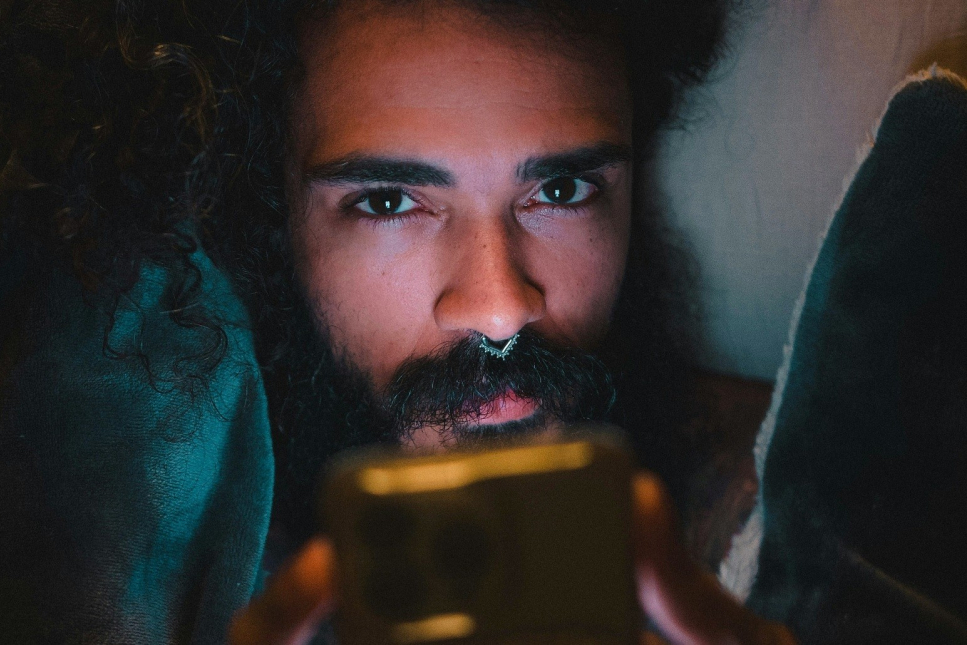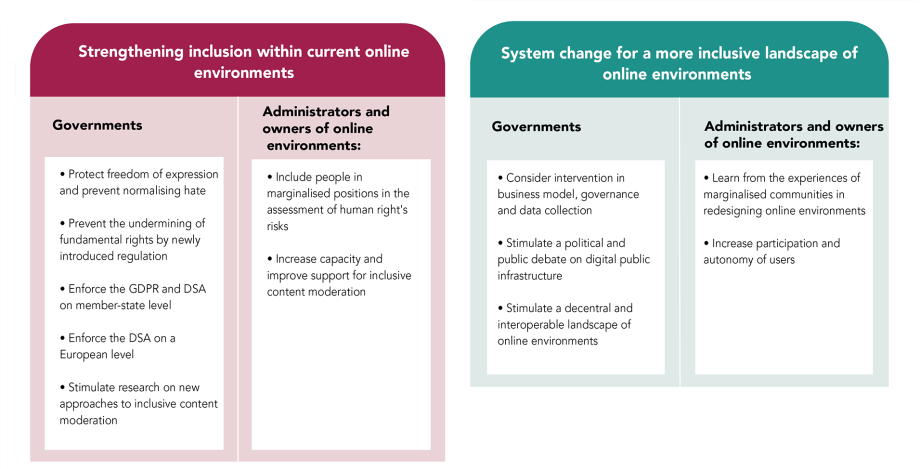Inclusive online (summary)
Towards design of apps and environments where people can be free and safe
Report
Downloads
-
Appendix: speculative prototypes
file type pdf - file size 3.99 MB
Download Speculatieve prototypes - Inclusief Online - Rathenau Instituut

Who designs, determines. That sums up the Dutch report 'Inclusief online – Naar een ontwerp van apps en omgevingen waar mensen vrij en veilig kunnen zijn' in three words.
In the report we present options for action to help build apps, platforms and other online environments where people feel free and safe.
With this research, we want to contribute to a better understanding of the preconditions and methods for achieving more inclusive online environments. Our goal is to ensure that everyone can eventually participate in online spaces in an equal and humane way. We also provide insight into important design choices behind online environments, such as the business model, governance and ways of data collection. That's important, because the design choices behind the online environments that many people use daily are not neutral. These choices actively shape the conditions of interactions in online environments and influence who has access to these environments, and what people are allowed to see and share in them.
Research method
In our research, we conducted a case study on the experiences of LGBTQI+ people in online environments. These experiences highlight important preconditions for more inclusive design. We chose this case study because LGBTQI+ people are disproportionately exposed to online hate, yet they also benefit greatly from online spaces where they can express themselves freely. A lot is at stake for this community, which makes their experiences especially valuable in showing how online environments can be designed more inclusively for everyone.
In our report, we combine qualitative research (interviews and literature review) with a design trajectory. In that design process, we, together with a group of Dutch LGBTQI+ people, looked at how online environments could become more inclusive. And what preconditions for more inclusive design are important for this to happen.
Results
This research shows that online environments can potentially offer people a lot.
Inclusive online environments require a number of preconditions:
- Space for self-expression and identity
- Space for connection and belonging
- Safety and privacy
- Control and autonomy
- Inclusive content moderation
We want to understand how these preconditions can lead to a more inclusive design of online environments. This report introduces the Design choice model for online environments, to make differences in design choices visible. The model consists of two main layers that are closely intertwined.
Upstream, owners and maintainers of online environments make choices about the business model, vision and governance of online environments. Think of decisions about ownership or how content moderation is handled. These choices set the stage for, or limit, other design decisions. For example, the business model, often based on offering personal advertisements, has a direct influence on the need for tracking, the choice for personalised algorithms and the retention of users' attention. Governance defines who controls design, rules, and enforcement in an online environment. How interoperable or centralised a system is often depends on its business model.
The choices made upstream affect other design choices downstream. Important design choices are also made at this level: not only about data collection and processing, but also about the appearance of the user interface. Data collection and processing forms the basis of the operation of today's online environments. Choices for how to profile and recommend affect how people experience online environments. Choices about the user interface are immediately visible to users and either enable or restrict their behaviour. This is what users have to deal with on a daily basis. For example, what design choices are made in terms of personalised algorithms, visibility and adaptability?
The combination of these design choices upstream and downstream affects the outcomes for users. Users participate in online environments designed to encourage certain types of behaviour and discourage other forms of being. That affects the outcomes they experience. These can be both positive and negative: environments can contribute to self-expression and connection, but also contribute to insecurity and self-censorship.
The outcomes that people face online are ultimately influenced by a layered system of design choices in which economic interests play a dominant role. Because a limited number of online environments now account for a large share of people’s internet use, a small number of parties are making important decisions that affect users.This makes it important to focus not only on potential downstream changes, such as limiting screen time, but also on interventions that touch on upstream design choices, in the area of business models, vision and governance.
Speculative prototypes
Speculative prototypes can help envision what an online environment might look like if values such as self-expression, safety, and autonomy were taken as the starting point for design. In this report, we present two speculative prototypes based on the preconditions for inclusive online environments: control over sharing and human in the loop.
The first speculative prototype gives users control over who can see their content and alerts them in cases of unexpected virality. This differs fundamentally from current online environments that are geared toward scale and data collection,
The second prototype makes the moderation process transparent and human, providing insight into decisions and the possibility of direct conversation with a moderator. This is a fundamentally different approach from today’s automated, impersonal systems. Both prototypes illustrate how alternative design choices can contribute to more inclusive online environments.
Not only for LGBTQI+ people
Over the past fifteen years, the pluralism of online environments has decreased, and design choices have been made that have not always supported user agency. Yet online environments have the potential to play a key role in fostering self-expression and connection in our society. They have become, in effect, important public spaces where people come together.
For the development of inclusive online environments, it is necessary to focus not only on symptom management, such as more enforcement against online hatred, but also focus on more fundamental design choices. As we have seen, the way online environments handle governance, their degree of interoperability, and the business models of their operators, all have a significant impact on the user interface and ultimately on the user experience.
The preconditions identified in this study are not unique to LGBTQI+ people. Self-expression and connection are important for everyone. Other groups who face scrutiny over their expressions and ability to connect in the physical world would also benefit from more inclusive online environments. The preconditions of safety and privacy, control and autonomy, and inclusive content moderation can inspire alternative approaches to design and regulation that make the internet a better place for everyone.
Options for action
Although fundamental rights such as freedom of expression, privacy, and safety are legally enshrined, they are still insufficiently realised online. The way many online environments are currently set up, with centralised governance and data-driven business models, is at odds with user agency and inclusion. At the same time, the pluriformity of the online landscape is declining, further limiting user choice. This presents an urgent challenge for both governments and administrators of online environments.
This report outlines two directions for improvement: strengthening inclusion within current online environments , and system change focused on a more inclusive landscape of online environments.
The first direction calls for a government that steps in to protect freedom of expression and prevent normalising hate. It highlights the caution governments should take when introducing new measures that can potentially impact fundamental rights, especially concerning minors and marginalised communities. When taking measures impacting anonimity online or preventing access to information, caution should be taken. This direction also includes better enforcement of existing frameworks, such as the Digital Services Act (DSA), as well as concrete measures by administrators of online environments, such as in the area of content moderation.
The second direction underscores that more inclusive online environments are only possible through fundamental decisions about business models, design principles, and governance. It also highlights the need for a political and public debate on digital public infrastructure and the stimulation of a more decentral and open landscape of online environments. Administrators of online environments can learn from the experiences of marginalised communities in redesigning online environments. Moreover, they can take measures to increase the autonomy of users.
A more inclusive and diverse internet for everyone calls for political and societal decisions about public digital infrastructure and intervention in fundamental design choices. Both directions contain concrete action points for governments and administrators of online environments, with the aim of creating online spaces where everyone can express themselves freely and safely.

Please download the summary or the full Dutch report for a complete overview of the options for action.

Want to read more?
Please download the full Dutch report for all content or sign up for an Engish spoken webinar about the outcomes of this research. (Wednesday October 8th at 4PM CEST)
Sign up: https://forms.office.com/e/aWip9XL2dD.